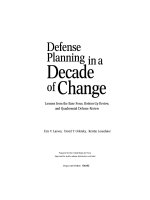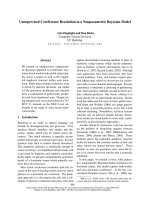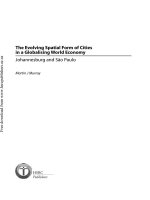Central-Bank Interest-Rate Control in a Cashless, Arrow-Debreu Economy pot
Bạn đang xem bản rút gọn của tài liệu. Xem và tải ngay bản đầy đủ của tài liệu tại đây (160.5 KB, 8 trang )
Central-Bank Interest-Rate Control in a
Cashless, Arrow-Debreu Economy
Neil Wallace
∗
February 18, 2004
Abstract
A pure-exchange, competitive economy with date-specific units of
account is studied. It differs from the standard pure-exc hange model in
having unit-of-account endowments. For suc h an economy, conditions
are given for an outside agent, a central bank, to be able to con trol the
nominal rate of interest. It can do so provided it has positive unit-of-
account endowments. A more general outside agent that has a positive
endowment of some good and positive unit-of-account endowments can
select the time path of the price level.
1Introduction
Money is often described as having three functions: (i) a unit-of-account func-
tion, (ii) a medium-of-exchange function, and (iii) a store-of-value function.
In a cashless economy, the third is not operative and, probably, neither is the
second. To lay people, the notion of a cashless economy may seem strange.
To economists, it is not at all strange. After all, the theory of relative prices,
the modern competitive version of which is called the Arrow-Debreu model,
has always been the developed part of economics. It is monetary theory
that has alwa ys been undeveloped. And, as it happens, the Arrow-Debreu
model has room for a unit of account–what is called an abstract unit of
account, abstract in the sense of not hav ing a physical counterpart. This
∗
Department of Economics, The Pennsylvania State University, 608 Kern, University
Park, Pa., 16802; email: ; tel 814-863-3805; fax 814-863-4775.
1
note describes conditions under whic h an activity that resembles central-
bank open-market operations determines n ominal interest rates in a simple
Arrow-Debreu model.
2 A two-date model
The model is of a 2-date, pure -exchange economy with N people and L goods
at each date. In order to make the model fit the unit-of-account vision t hat
people seem to have in mind for a cashless economy, my v ersion has date-
specific abstract units of accoun t called date-1 ecus and date-2 ecus. Goods
are i ndexed by l ∈ {1, 2, ,L} and people by n ∈ {1, 2, , N}. Let ω
n
t
∈ R
L
++
denote person n
0
s endowment vector of date-t goods. Although somewhat
non standard, I will also endow people with ecus at each date and let e
n
t
∈ R
denote person n
0
s endowment of d ate t ecus. (I permit e
n
t
to be positive or
negative. A negative ho lding is a debt denominated in date-t ecus.) Note
that all the objects are perishable. For goods, that is what pure exchange
means. For ecus that is one of the meanings of cashless: there is no technology
that permits a person to con vert ecus at one date into ecus at another date.
Let c
n
t
∈ R
L
+
be n’s consumption vector of date t goods. Person n has a
utility function, a function of consumption of goods, u
n
: R
2L
+
→ R, which
is strictly increasing. Also, let x
n
t
denote person n
0
s consumption or end-of-
date-t holdings of date-t ecus. As implied by the function u,peopledonot
value consumption of ecus, j ust as they do not value consumption of cash in
acasheconomy.
Definition 1 Person n can afford non negative (c
n
1
,c
n
2
,x
n
1
,x
n
2
) at the prices
(p
1
,p
2
,R) if
(p
1
ω
n
1
+ e
n
1
− p
1
c
n
1
− x
n
1
)+R(p
2
ω
n
2
+ e
n
2
− p
2
c
n
2
− x
n
2
) ≥ 0. (1)
The restriction x
n
t
≥ 0 should be interpreted as a no-reneging condition. If
x
n
t
< 0, then a person leaves date t owing date-t ecus. That is not permitted.
Notice that the nominal interest rate is
1
R
− 1. Given that definition of what
apersoncanafford, we can define a competitive equilibrium (CE) as f ollows.
Definition 2 ACEis(c
n
1
,c
n
2
,x
n
1
,x
n
2
) for each n and (p
1
,p
2
,R) such that (i)
(c
n
1
,c
n
2
,x
n
1
,x
n
2
) maximizes u
n
subject to being affordable at (p
1
,p
2
,R), and (ii)
the allocation is feasible; that is,
P
n
c
n
t
≤
P
n
ω
n
t
and
P
n
x
n
t
≤
P
n
e
n
t
for
t =1, 2.
2
This definition does not include equilibria in which either or both of date-
1 ecus and date-2 ecus are worthless. In general, there are such equilibria.
Therefore, when w e describe necessary conditions for a CE that satisfies
definition 2, they are necessary conditions for a CE in which date-1 and date-
2 ecus have value. Consideration of such equilibria is similar to consideration
of valued-cash equilibria in models with cash. Often, those models also have
equilibria i n which cash is not valued.
If there are no endowments of the unit of account– that is, if e
n
t
≡ 0–
then this is (a special case of) the standard pure-exchange model. And it
has the standard zero-degree homogeneity property.
Claim 1 If (c
n
1
,c
n
2
) for each n and (p
1
,p
2
,R) is a CE, then (c
n
1
,c
n
2
) for each
n and (γ
1
p
1
,γ
2
p
2
,γ
1
R/γ
2
) is a CE for any (γ
1
,γ
2
) ∈ R
2
++
.
Proof. Obvious.
Notice that this implies that there is a sense in which R ∈ R
+
can be
selected arbitrarily. Suc h a selection can be interpreted as influencing the
inflation rate between dates 1 and 2 because R has the units date-1 ecus per
unit of date-2 ecus.
No w suppose that there are endowments of ecus. Then, for some prices,
some people may have negative wealth. That may cause problems for exis-
tence of a CE. If a CE exists for given ecu endowments, and if those endow-
ments are held fixed, then there would seem to be what has been called real
indeterminacy because as prices vary the wealth distribution varies. I will
duck the existence question here and deal with properties of a CE.
Claim 2 In any defin ition 2 CE, (i) prices a re positive (p
1
> 0,p
2
> 0, and
R>0)andx
n
t
≡ 0 and (ii) the feasibility conditions hold at equality and
P
n
e
n
t
=0.
Proof. Part (i) follows from monotonicity of u. Asforpart(ii),mono-
tonicity of u also implies that (1) holds at equality, and, therefore, that the
sum of (1) ov er n holds at equality. Then, because prices are positive, the
sum of (1)) over n implies that the feasibility conditions hold at equality.
That and x
n
t
≡ 0imply
P
n
e
n
t
=0.
The conclusion
P
n
e
n
t
= 0 is reassuring. It says that total endowments
of ecus at each date are zero. In other words, claims on d ate-t ecus are offset
by debts of date-t ecus.
3
And, as is standard, i f we a djust ecu endowments appropriately, then the
zero-degree homogeneity property holds.
Claim 3 If (c
n
1
,c
n
2
) for each n and (p
1
,p
2
,R) is a CE for ecu endowments e
n
t
,
then (c
n
1
,c
n
2
) for each n and (γ
1
p
1
,γ
2
p
2
,γ
1
R/γ
2
) is a CE for ecu endowments
γ
1
e
n
1
and γ
2
e
n
2
for any (γ
1
,γ
2
) ∈ R
2
++
.
Proof. Obvious.
3ACentralBank
Subject to the abo ve proviso about existence, it seems that the nominal
interest rate can be anything. Therefore, there would seem to be scope for
an outside entity, the central bank, to choose the nominal interest rate. One
way to think of a cen tral bank as enforcing a particular magnitude for the
nominalinterestrateistohaveitoffer to buy date-1 ecus for da te-2 ecus, and
vice versa. This would seem to be the analogue of open-market operations.
To explore this, let us label the central bank agent 0. Assuming, as is
natural, that the central bank does not deal in goods and does not have
endo wments of goods, we can regard it as choosing non negative x
0
1
and x
0
2
subject to the following special case of (1):
e
0
1
− x
0
1
+ R(e
0
2
− x
0
2
)=0. (2)
We can interpret e
0
t
− x
0
t
as the central bank’s sale (purchase if negative) of
date-t ecus. Then, (2) says only that the central bank trades a t a price.
Because the central bank does not maximize utility in any ordinary sense,
we do not assume that it necessarily chooses x
0
t
=0. However, we do assume
that it is also subject to x
0
t
≥ 0: it cannot leave date t owing date-t ecus.
Because t he central bank does not deal in goods and does not maximize
utility, the only amendment needed in the definition of a C E is to replace
the f easibility condition for ecus to include agent 0. And because (1) holds at
equality for each private agent and (2) holds, it follows that such feasibility
implies
P
N
n=0
x
n
t
=
P
N
n=0
e
n
t
for t =1, 2. And because x
n
t
=0forn 6=0in
any CE, a necessary condition for a CE is
x
0
t
− e
0
t
=
N
X
n=1
e
n
t
for t =1, 2. (3)
4
Notice that for general private endowmen ts of ecus, endowments that do
not satisfy
P
N
n=1
e
n
t
=0, (2) a nd (3) are inconsistent. Therefore, we continue
to assume that
P
N
n=1
e
n
t
=0, the necessary condition for a CE when there is
no central bank. Under that assumption and the assumption that the cen tral
bank has positive endowments of ecus, an assumption discussed below , it c an
be shown that the central bank can make an arbitrarily c h osen R a necessary
condition for a CE.
Claim 4 Assume
P
N
n=1
e
n
t
=0and e
0
t
> 0 for t =1, 2. For any
ˆ
R ∈ R
++
,
the central bank (agent 0) can be have as a price taker in such a w ay that a
necessary condition for a CE is R =
ˆ
R.
Proof. We have to construct behavior for agent 0. Let the function
f(R) determine the choice of e
0
1
− x
0
1
, with e
0
2
− x
0
2
giv en by (2). Let f :
R
+
→ (−
ˆ
Re
0
2
,e
0
1
) be strictly monotone, contin uous, and satisfy f(
ˆ
R)=0.
The bounds on the range of f are chosen to satisfy x
0
t
≥ 0. Now, suppose, by
way of contradiction, that there is a CE with R 6=
ˆ
R. Bythechoiceoff, this
implies x
0
t
− e
0
t
6= 0. But this violates (3), a necessary condition for a CE.
There seems to be nothing more to this proof than the idea that if the
central bank chooses to supply something for which private excess demand is
perfectly inelastic at the quantity 0, then equilibrium requires that the price
be such as to make the central bank willing not to supply it.
Positive endowments for the central bank play an important role. In
particular, if the central bank has no endowments, then its budget constraint,
(2), and x
0
t
≥ 0implyx
0
t
− e
0
t
= 0 at all R. How do we interpret positive
endowments for the central bank simultaneously with
P
N
n=1
e
n
t
=0?Iam
not sure. Perhaps t he positive central-bank endowments are the analogue of
the central bank’s power in a cash economy to print cash at any time.
It may seem odd to claim that the central bank can determine the nominal
interest rate without providing a proof that there exists such an equilibrium.
Theknownexistenceresultsareforversions without endowments of the date-
specific units of account, versions in which the magnitude of the nominal
interest rate does not matter in the above model. Almost certainly, those
existence results can be extended. After all, by choosing p
1
and p
2
to be
sufficiently large, given unit-of-account endowments can be made arbitrarily
small in real terms. And setting a nominal interest rate does not preven t p
1
and p
2
from being arbitrarily large.
5
4 Fiscal and monetary policy
Notice, of course, that control of R as just described leaves one degree of
indeterminacy. It is tempting, therefore, to describe a somewhat more general
policy, one that would eliminate all indeterminacy. Now, I assume that agent
0 has, in addition to endowments of ecus, some of one of the goods. Without
loss of generality, let it hav e an endowment of good 1 at date 1, denoted ω
0
11
.
I will not describe where it obtained this endowment. One can think of it as
coming from a bit of lump-sum taxation, which is why I call the policy being
described fiscal and monetary policy. Just as the agent 0 ecu endowments
only had to positive, not large, I only require that ω
0
11
is positiv e.
NowIcanshowthatthereisawayforagent0tobehave,behavein
the sense of having an excess demand function, that allows it to determine
both p
11
, the price of good one − one,andR. Before doing t hat, I have to
again amend the definition of a CE. Once again, agent 0 does not maximize
anything. Hence, we need only amend the feasibilit y conditions to include
agent 0. I assume that agent 0 consumes at most some of good one − one.
As a c onvention, I define its consumption, denoted c
0
11
, to be the amount of
good one − one it has after trading. Then the feasibility conditions hold at
equality.
Claim 5 Assume
P
N
n=1
e
n
t
=0and e
0
t
> 0 for t =1, 2 and ω
0
11
> 0.For
any (p
∗
11
,R
∗
) ∈ R
2
++
, agent 0 can behave as a price taker in such a way that
a necessary condition for a CE is (p
11
,R)=(p
∗
11
,R
∗
).
Proof. We construct behavior for agent 0. Let the function f(p, R):
R
2L+1
+
→ R
2L+2
denote the excess demand for agen t 0. We suppose that
f(p, R)=f(p
0
,R
0
)ifp
11
= p
0
11
and R = R
0
.Moreover,f(p, R) ≡ 0except
for good one − one and ecus. Aside from continuity, we let the sign of excess
demand for the vector (f
11
,f
2
), excess demand for good one − one and for
date-2 ecus be as indicated in figure 1 with f
1
,excessdemandfordate-1
ecus, determined by the agent-0 budget constraint at equality. In addition,
let f be continuous. Now, suppose, by way of contradiction, that there is a
CE with (p
11
,R) 6=(p
∗
11
,R
∗
)). By the choice of f, this implies x
0
t
− e
0
t
6=0for
some t. But t his violates (3), a necessary condition for a CE.
The i dea is the same as in the proof of claim 4. The private sector cannot
be either a net supplier or demander o f ecus at either date. Therefore, given
thatagent0isanetsupplierordemanderatpricesthatdonotsatisfy
6
(p*
11
,R*)
p
11
R
(-,+)
(-,0)
(-,-)
(0,+) (,0,-)
(+,+)
(+,0)
(+,-)
Figure 1: Sign of (f
11
,f
2
).
(p
11
,R)=(p
∗
11
,R
∗
), satisfaction of this equality is necessary for a CE. By
the way, while the behavior posited in the proof of claim 4 is consistent with
a CE in which ecus at both dates are worthless, that is not the case for the
behavior posited in the proof of claim 5. As should come as no surprise,
the willingness of agent 0 to sell goods for ecus prevents ecus from being
worthless.
Finally, it is obvious that nothing in these argumen ts hinges on there
being only two dates. The results apply for any finite number of dates.
5 Concluding remarks
The above model is disarmingly simple. It can be because it does not have
to confront the hard problems of modeling cash economies. Because no one
holds cash from one date to the next, there is no need to explain why peo-
ple hold non interest-bearing cash when they seem to have available assets
with higher rates of return. Also, there is no zero lower bound on nominal
interest rates. This bound arises in an economy with cash because people
have available a technology for converting cash at the current date into cash
in the future; namely, s toring it under their mattresses. In a cashless econ-
omy, there is no such opportunity and, therefore, no lower bound on nominal
interest rates. Also, for cashless economies, there is no terminal condition
problem concerning why cash has value at a last date.
But simplicity it not an end in itself. Suppose we were to require not only
that the model be cashless, but that it be a limit of a cash economy, a limit
7
as something in the economy makes cash disappear. If we take that sensible
view, then we have to face all the hard problems of monetary theory: we
have to decide what cash (monetary) model we like and what limit to take
to produce cashlessness.
In that regard, some recent w ork on monetary models takes a mechanism-
design point of view and requires that money play a beneficalrolerelativeto
all feasible mechanisms. That work concludes that such a monetary model
must have sev eral frictions relative to Arrow-Debreu. For example, in [1],
individuals cannot commit to future actions and there is imperfect public
monitoring of past individual actions in the form of an updating lag of the
public record of individual actions. Remove either and you get a cashless
economy. However, if y o u only remove the imperfect monitoring by letting
the lag get short, which is what seems to be happening in actual economies,
then you get a cashless economy that is not an Arrow-Debreu model. Thus,
it should not be taken for granted that the cashless limit of interest is an
Arrow-Debreu model.
References
[1] Kocherlakota, N., and N. Wallace, Optimal allocations with incom plete
record-keeping and no commitment. J. of Economic Theory,1998,272-89.
8









